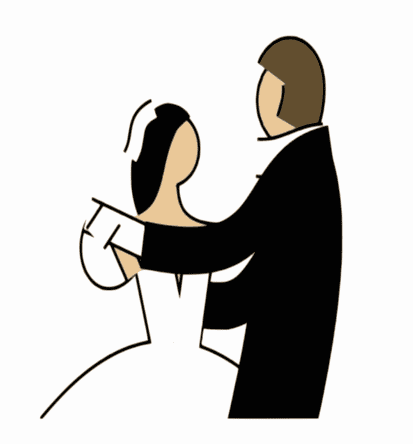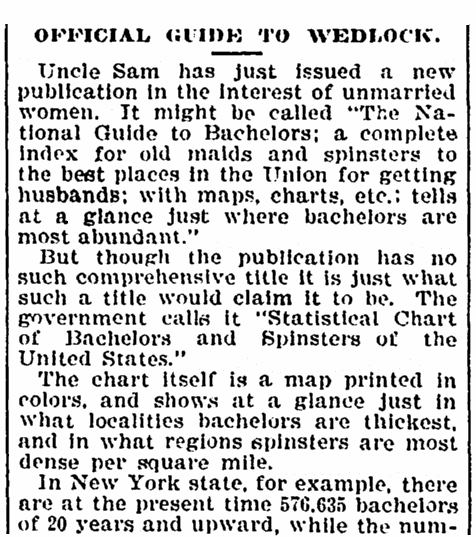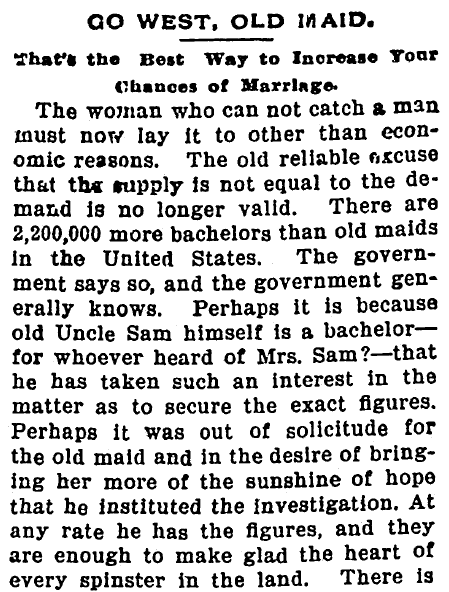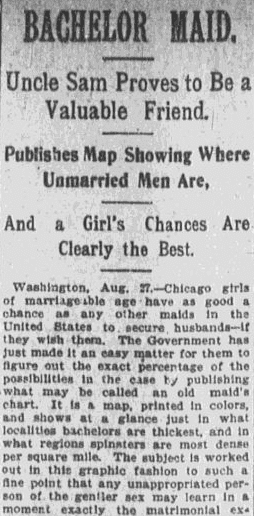Introduction: Gena Philibert-Ortega is a genealogist and author of the book “From the Family Kitchen.” In this blog article, Gena searches old newspapers to learn about a time – in 1898 – when the U.S. government published a report and map to help unmarried women locate bachelors throughout the country.
Having trouble finding a marriage partner? Whom should you turn to for help? A matchmaker? A family member or friend? How about Uncle Sam?
Yes, Uncle Sam. Uncle Sam entered into the matchmaking business with the publishing of a 19th century U.S. Census Bureau report. This work was unique in that it addressed where to find an eligible bachelor based on location. According to the dissertation “Unclaimed Flowers and Blossoms Protected by Thorns: Never-Married Women in the United States, 1880-1930” by Jill Frahm*:
In 1898, the U.S. Census Bureau published what the popular press dubbed an “Old Maids Chart” graphically illustrating at a glance in what localities bachelors [were] the thickest, and in what regions spinsters [were] most dense per square mile.

Using the now lost-to-us 1890 census (much of it was destroyed in a 1921 fire), the report documented “the number of single men and women over the age of twenty in each state.”
Statistical Chart of Bachelors and Spinsters of the United States
While officially titled the “Statistical Chart of Bachelors and Spinsters of the United States,” an 1898 Colorado newspaper article suggested a more tongue in cheek title:
The National Guide to Bachelors; a complete index for old maids and spinsters to the best places in the Union for getting husbands; with maps, charts, etc.; tells at a glance just where bachelors are most abundant.

Newspapers across the United States reported on the findings of this report. Like any article picked up by the wire services, some reports contained more information than others – and in some cases included the writer’s personal opinion.
How Many Eligible Bachelors Are There?
Did late 19th century spinsters believe that their lack of a marital status was the result of too few good men where they lived? While this was true during certain time periods like immediately after the American Civil War or in Britain after World War I, that doesn’t really seem to be the case in 19th century America, according to this 1898 Kansas newspaper article which stated that there were 2,200,000 more bachelors than old maids in the United States. (It’s important to remember that in reality not all of the men counted as single in the census would have been eligible bachelors. Some may have been institutionalized or incarcerated for example).
The article reports:
There is not a state in the union where there are as many old maids as bachelors. Even Massachusetts, the traditional home of the spinster of the poll-parrot species, has more men than women of marriageable age.

The article says “old maids” should have good luck finding bachelors anywhere in the U.S. – but it especially urges spinsters to “Go West”:
But if she wants a territory where negotiations may be completed with even greater ease – where the lottery of marriage must become a dead sure thing – let her hie herself from the crowded cities of the east to the rolling prairies or mountain wilds of the west, where there are ten bachelors to every available maiden. What spinster can resist such an advantage as this, which is offered by the states of Idaho and Wyoming? It would surely be a hopeless case which would not find its cure with the chances ten to one for recovery. Let the old maids try the free, fresh air of these mountain lands for awhile.
Where was the best place for a 19th century “old maid” to find a husband? Probably not too surprisingly, the western states of Idaho and Wyoming. Whether or not it was true, a popular belief was that young men were heading west to seek their riches, thus leaving behind single women in the New England states.
Some editorializing occurred with the publishing of this government report, including the stereotypical views regarding why marriage eluded some women. In this 1898 Massachusetts newspaper article, the rather derogatory point is made that:
With these figures in hand it ought not to be hard for the average lonely spinster to hunt down a husband and corner him, so to speak. She need not be attractive; a woman does not need many charms to secure a mate in a region like Idaho or Wyoming, where there are ten bachelors for every available maiden.

When Are You Getting Married?
So was every New England spinster chomping at the bit to go west to seek her (husband) fortune? Maybe not, according to author Betsy Israel. In her book Bachelor Girl: The Secret History of Single Women in the Twentieth Century she writes:
…very few unwed New England women were inclined to trek after men into the wilderness. The self-educated spinster, in particular, understood just what was in store for her “out there.”
She goes on to point out that a good number of children were needed to help out on farms, and that farm work was hard and giving birth was dangerous, with 1 in 25 pioneer women dying in childbirth.** Other authors have also suggested that professional opportunities for women after the Civil War may have resulted in many women delaying marriage. Economic and educational opportunities may have also influenced where women lived, so they were not necessarily sitting idle in their hometown, left behind by men seeking their fortune.
An online collection of newspapers, such as GenealogyBank’s Historical Newspaper Archives, is not only a great way to learn about the lives of your ancestors – the old newspaper articles also help you understand American history and the times your ancestors lived in, and the news they talked about and read in their local papers.
Do you have a “spinster” aunt in your family tree? Or do you have a female ancestor that headed west to find a husband? What’s her story? Please share it in the comments below.
————————-
* Franhm, Jill. Unclaimed Flowers and Blossoms Protected by Thorns: Never-Married Women in the United States, 1880-1930. Dissertation. University of Minnesota. p. 142-143. Available at http://conservancy.umn.edu/handle/11299/96235.
** Israel, Betsy. Bachelor Girl: The Secret History of Single Women in the Twentieth Century. New York: William Morrow. p. 22.
Related Marriage Articles:

We have a mail order bride in our family.
A 68 year old widower ancestor in ND married a 61 year old never-married lady from CT in 1942. This was always talked about as a mail order bride.
http://nodakgenealogy.com/wp-content/uploads/MM9.3.1_2FTH-267-11580-5849-10.jpg
Ted
Personally I like William Atzinger and his attitude about marriage & having to pay the bachelor tax or go to jail. found in 7 May 1921 Lexington Herald (KY) pg 4